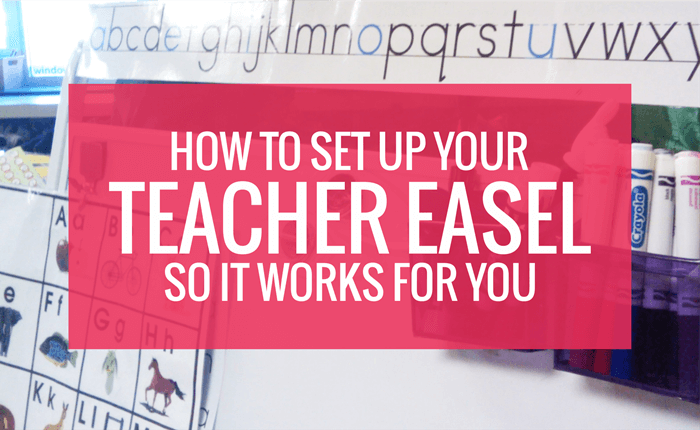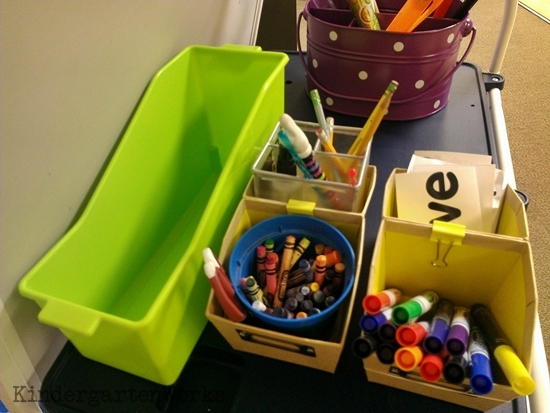How to Set Up Your Teacher Easel So it Works For You
If you have an easel in your classroom, it is a great for keeping teaching tools handy. But, it can quickly become cluttered and disorganized.
Here’s how to set up your easel – behind, in front and underneath – so that it is functional and stays clear.

Let’s look at each section and plan what you need to make it work for you.
I’m going to use my easel as an example since I essentially changed my easel’s color scheme so it was calmer and I organized the space in a way that was more useful to me.
Behind the easel
Some easels come with different features, but if yours has one of these you can apply the tips that will work for you.
1. Basket storage
If your easel has baskets, you want them to be functional. Use them for bulky items that you don’t need every day or organize them with smaller inserts to keep things tidy.
My teacher easel came with four primary-colored slide-in baskets that you could slide in and out from the left and right sides.
I did “use” them for a year or two until I really felt like I grew to loathe them. They weren’t functional – I never knew what to store in them and it felt like they collected dust and clutter.
…And they were red, blue yellow and green. None of those colors existed anywhere else in my classroom. It felt like an eye-sore.
Here was my fix: I removed the primary-colored baskets that it came with and slid in two sturdy (affiliate) Sterilite white ones.

These drawers don’t slide as easily, but I use them more for storage (when I had bulky project items) rather than daily access.
Doing this made this entire easel become white. It was more calming and just awesome.
So, use your baskets or tubs in a way that suits you most – but make sure that if you’re going to use them for anything other than storage that they are easy to access.

Be sure to check these baskets about every Holiday for random things that find their way in and toss them or put them back where they belong. This helps you keep from piling up clutter.
2. Shelf space
If your easel has a shelf – that’s handy.
A shelf behind the easel can easily become a catch-all space so consider how you want it to function before you set it up.
I wasn’t a fan with what came behind the whiteboard. It had tall, yellow wires to hold big books. I did try to use them, but it felt like wasted space when I could easily leave a book on the front shelf or tuck it underneath the easel all together.

I took those out.
Instead, I like organizing the large shelf with smaller containers.
It works better for me to grab what I need and return it without chucking things randomly behind and making an outright mess. Seriously, I have an issue with this. I can be so lazy sometimes.
And well, this backside of my easel is highly visible from the entrance of my room this year, so smaller containers help me stay on my toes and keep it organized.
I use a magazine box with a sturdy base to hold read-alouds.

I use mini binder clips to hold Target dollar spot square bins together to create stability and to keep things from getting knocked off the shelf.
In these square bins I keep:
- markers for using on chart paper
- crayons for modeling
- scissors
- small pointers
- sight word word-wall cards

And there are smaller, honestly, kinda random inserts to better hold up my mini-pointers, pencils and for the crayons as well.
Those things tend would otherwise lay down too much in the baskets to be easily seen and grabbed when I’m in the middle of teaching.
But they are all a necessity. I need them within reach of my rocking chair.
Those materials only take up half of the shelf.
A utensil caddy sits on the other half of the shelf.

It holds larger pointers and keeps them under control.
I don’t let anything else pile up back here other than a stack of student math journals that get checked daily.

This becomes like a standing work station when I quickly grade those math journals since I have a marker right there… and standing forces me to get them done asap.
If you have a shelf, then consider what needs to be within your reach every single day and put it right there.
Use containers, inserts and whatever else you need to help you keep it organized and functional when you’re grabbing and putting it back so often without it becoming a catch-all space.
Tidy up this space at the end of every day or at the end of the week when you’re refreshing the books or papers you put behind it. It will take an extra 30 seconds, but that’s about it to keep on top of this space.
Front of the easel
Let’s take a look at the front of your easel.
You probably have a dry erase, whiteboard or wooden surface. It’s meant mainly for displaying or writing on. It probably comes with a little ledge.
The goal of this space is to keep it clear.
I try to keep what sits on the whiteboard ledge paired down because it’s easy to let this space fill up during the day.

I keep a large writing chart tablet out. But I can remove and set it underneath (on top of the white drawer units) when we need the whiteboard space.
Tip: You can cut the bottom 5-6 inches off of writing chart table on a paper cutter and the height will be much more user-friendly yet still be large enough to accomplish your writing. Don’t like to waste? Bind the bottom 5-6 inches to create a sentence strip booklet.
I use dry-erase markers multiple times a day while I’m teaching from here so I keep them on the front.

But I don’t leave them on the ledge. They stay in a magnetized locker holder (from the dollar tree) up in the top corner.
I had a few magnets too since they make it easy to move things around on the board.
I also created an alphabet strip to go along the top in calming colors. That’s just taped on.

Keeping things handy but up and out of the most-used display space area is key for setting up the front of your easel.
So pick only what you really need and allow those things to live on the front of your easel. Then create a place for them to live (that isn’t on the ledge) that maximizes the display space left.
Under the easel
Some easels come with open space underneath. Use this to your advantage.
But carefully consider what you put here so these things don’t go to die a dusty death.
1. Don’t be afraid to change it up
Turn your storage space under your easel into useable space.
I always felt that the space underneath the easel was essentially wasted space. Remember those ugly primary-colored baskets I mentioned earlier? Well, I never did replace the two on the bottom rung.
This year, I added white and clear (affiliate) Sterilite drawer stacks and I instantly had much more useable storage space that was practical.

I love how the white visually anchors the space, makes more functional space but also helps keeps the teacher easel from moving.
Note: These drawers were actually the topper drawer pieces from all around my room. (See the other set of drawers in the back left corner?) They had been taken off from those stacks (so they’d fit under our tables) and I simply reassembled them here to create a new stack that fits perfectly underneath the easel.
So, use what you’ve got an don’t be afraid to change it up from what you’ve been handed. If your easel isn’t working for you – change it!
2. Plan something boring
We teach kindergarten.
They have busy minds and busy hands.
If you use space under your easel for storage, do yourself a favor and only keep boring things in there… or you’ll have busy little hands in there while you’re trying to teach.
Consider what else you need to have close to you.

I used the drawers in the front to hold a class set of lap whiteboards and some big books.
Nothing too exciting.
The three drawers in the back held our poetry center materials. But, they couldn’t access that from the front when I was teaching.
So, if you keep it at their level, keep it boring.

I ended up loving this storage space the most because it took care of storing two things for me that I otherwise kinda-hated storing. It made passing out whiteboards super simple and grabbing a big book that I had set aside for the week easy.
There you have it – you can set up your easel to be functional and look good without becoming cluttered. Keep what you need at hand and don’t be afraid to change up what you were given to what will work for you.
Now do tell… What tips do you have for keeping your easel organized?
If you like what I do here on KindergartenWorks, then be sure to subscribe today. I look forward to sharing ideas with you weekly.







I completely dislike my easel. It’s actually a art easel given to us to use for teaching. I love my previous teaching easels and I am thinking about putting in a Donors Choose project for one my current school. The ledge broke off because it is wooden so I’ll have to get extra crafty in order to make use of what I have or get a new one 🙁
I think that sounds like a good plan. I’ve heard lots of success stories using Donors choose. Best of luck! Thanks for all of your comments today.
– Leslie
Thanks for posting about your easel organization! I use baskets with mine too, but it just doesn’t seem to stay as neat as I would like. 🙂
Lori
Conversations in Literacy
Oh man! Still looking for the basket solution that will work 😉 Let me know if you ever find one! Thanks for sharing your comment!
– Leslie